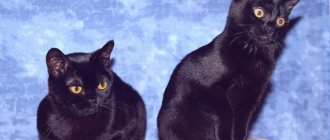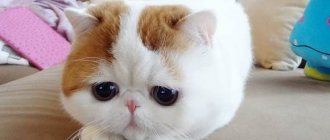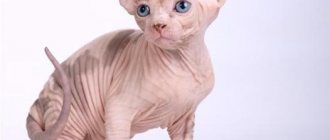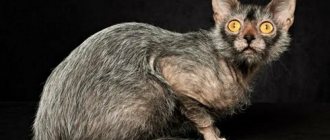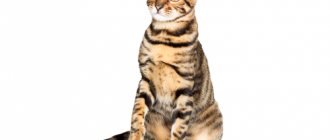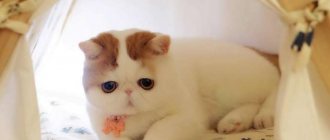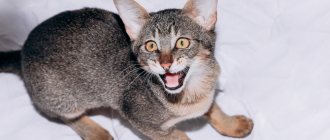History, character and description of the Persian Color Point breed
Color-points have come to their current appearance as a result of many years of selection. And in 1955 the breed received official recognition. They are classified in the Persian group because they have the long hair and body structure characteristic of the Persians. They have large heads and small ears, almost invisible due to their luxurious fur. They are squat and wide-boned. But the eyes are heavenly blue, inherited from the ancestors of the Siamese breed. As well as the color of the face, dark markings on the paws, tail (fluffy, like Persians), and ears. The Persian Colorpoint has a very long coat. For some it reaches ten centimeters. The color of a breed is determined not by the overall color of their coat, but by the color of their spots. The most popular is with dark brown markings. The main color of the fur can be ivory, and on the chest and belly it can be almost white. The spots are the color of dark chocolate. The dark mask on the muzzle reaches the ears and completely hides the eyes and truly Persian nose. But cats of this breed can also have a striped, smoky, or tortoiseshell color. But the eyes remain blue. In total, there are about two dozen colors of modern representatives of this breed.
What is the character of the Persian color point? And his ancestors took care of him. They, like the Persians, are completely domestic. But, Siamese “relatives” are reflected in excessive curiosity, activity and intelligence, and sometimes even cunning.
Cat health
Any cat, whether purebred or not, can have a genetic predisposition to diseases. Himalayans are more likely than other breeds to experience the following problems due to their genetics:
- Breathing problems. Like Persian cats, Himalayans have a short muzzle, which helps shorten the nasal passages. Cats of both breeds can have trouble breathing in hot, humid weather or due to excessive exercise.
- Incorrect teeth bite.
- Increased lacrimation
- Retinal atrophy, which can cause the kitten to go completely blind.
- Feline hyperesthesia syndrome is a disease of the nervous system in which the sensitivity of the purring skin increases sharply, causing it significant discomfort.
- High risk of heat stroke.
- Polycystic kidney disease. This is a disease in which the parenchyma of an organ is covered with small formations with liquid contents. In kittens, the size of the cysts does not exceed a few millimeters, but as the pet grows older, they increase in size and interfere with the normal functioning of the organ. This can result in urolithiasis and kidney failure.
- The oily form of seborrhea (Seborrhea oleosa) is a skin disease in which redness occurs on the skin, hair falls out, and the cat constantly scratches the area.
Attachment to family
Unlike Siamese cats, which have an unbalanced character, color-point cats are reasonable, sociable and calm. They love to be the center of attention and do their best to attract it. They are demanding of their owners and will not forgive a neglectful attitude towards themselves. Both a small kitten and an adult cat do not like to be left alone for a long time. Although, if you make sure that your pet has enough toys, a scratching post house with shelves, she is quite capable of staying in the apartment alone. Do not look at the fact that cats of this breed look clumsy in appearance. They love to run and play for a long time. This is important if you have children. They can have a great time together. They are not silent like Persian cats, but they are not as talkative as Siamese cats. If you are not the owner of a country mansion with an area where your pet can walk, then your cat will do just fine with walks on the balcony.
But one thing is important. These cats require one thing from their owners - attention. Giving your affection and affection in return. She can lie on your lap for long hours, purring with pleasure, and she will not care about your current affairs at all. The main thing is that she is happy, and her owner loves her.
How the breed appeared
Immediately after their appearance, the Persians became associated with the aristocracy. So, they were often taken in by celebrities and rich people. The Persians also found their way into art: in paintings, noble people were often depicted with these animals. The first mention of the Persian cat breed belongs to P. Valle and dates back to 1620. It was these animals that the man talked about when he described their import to Italy.
Also in the 17th century, red long-haired beauties became famous in France. Interestingly, the ancestors of these animals differ from the representatives that can be observed to this day. Some experts are inclined to believe that Persians appeared due to the crossing of Iranian and Angora breeds.
Thanks to the symbiosis in which the long-haired Iranian and white Angora cats were involved, representatives of the Persian breed appeared.
People really became interested in cats when they appeared in England. There they began to be studied, and in 1887 the breed was registered in the British breed book. Russia saw these cats only towards the end of the 19th century.
It is interesting that after the discovery of the breed, its representatives had wool of only two colors. So, previously there were only Persian blue and white Persian cats. The Persian cat with color point fur, the black Persian cat and animals with fur of other shades appeared later.
Care and care
Long-haired Persian Colorpoints are extremely demanding in care. Cats need to be bathed frequently and thoroughly brushed. They take water procedures calmly, and some even love them. The cat should be washed with a special shampoo, and under no circumstances with soap. Then you simply won’t comb their luxurious fur. Sometimes cats start to darken. For young pets, this can be a serious disadvantage at shows.
Cats can darken for genetic reasons and due to individual physiology. If a cat lives in a warm place, its coat is lighter. The temperature should be at least 20, but not more than 30 degrees Celsius. In extreme heat, your cat may begin to shed. Try to prevent your pet from spending a lot of time in the cold, or looking around on the balcony.
Caring for Himalayans
The most important thing in caring for a Himalayan cat is daily brushing and grooming of the pet's coat. The beautiful, long hair of the Himalayan cat cannot remain clean without human help. She needs to be thoroughly combed every day and bathed at least once a month.
Another major issue involves cat litter . The litter often sticks to the Himalayan cat's paws and fur. If you don't regularly clean your cat and the litter box itself, your cat may stop using it.
Excessive tear production is common in this breed, so rub the corners of the eyes to prevent under-eye spots. It is also advisable for Himalayan owners to brush their pets' teeth or give special additives to clean their teeth in order to avoid problems with gums. Typically, Himalayan owners are advised to brush their teeth about once a week.
It is also recommended that you never let your Himalayan cat roam freely. Cats of this breed do not have conflicts and do not fight well, so they will not be able to protect themselves from other cats and dogs. Another danger that awaits Himalayans on the street is the abduction of a pet by people who want to get such a beautiful cat for free.
Breed standards
The most characteristic feature of the breed is their nose. International standards divide cats into 3 types:
- Short-nosed or modern. In such animals, the lower eyelid and the upper part of the nose are approximately at the same level. Probably almost everyone has seen a photo on the World Wide Web showing a long-haired and red Persian cat with an upturned short nose.
- Classic or British. This type is currently considered obsolete. In appearance, animals belonging to the classical type are more reminiscent of ordinary cats. Their nose is usually straight and located slightly below the eyes.
- Extreme or American. In animals belonging to this type, the nose is usually located high on the muzzle. It is located approximately at eye level. Such animals are sometimes called snub-nosed animals.
Other breed standards:
- round head with fluffy ears;
- massive body;
- expressive, shiny and round eyes, widely spaced on the muzzle;
- a short and fluffy tail with a rounded tip;
- wool collar;
- hair between the toes on the pads;
- on the hind legs - wool pants;
- round, “hamster” cheeks;
- color red, black, red, blue and other shades.
How to choose a Persian kitten
First of all, you should pay attention to the purpose of the choice - if you want to participate in exhibitions, then the mother cat must be selected from a special club with a mandatory ideal pedigree and the cost will be correspondingly high. If the kitten is for home and for your soul, then you need to find out from the breeder about the type of breed, the health of the offspring, and the presence of diseases in its parents.
Advice! The breed type appears in the baby at about 2-4 months, this is the optimal time for choosing.
It is advisable to take the kitten out of its familiar environment so that you can assess its contact with other animals, find out whether it feeds itself and whether it is potty trained. A healthy kitten should show interest in everything around it, including you. He should be clean and his coat should be smooth.
The price of kittens varies depending on the type of cat and color; eye color is also important. The most expensive colors will be golden and silver chinchillas, solid (snow white, black), smoke and tortoiseshell calicos. On average, breeders offer to buy a two-month-old kitten for 5 – 15 thousand rubles.
blue kitten persian
gray bicolor
Features and character of the Himalayan cat
It should be noted that all color points are very friendly and calm. Himalayan cats love to communicate with people and get great pleasure from it. In many ways, the character of Himalayan cats depends on the conditions in which the cat grew up, as well as on how often it was interacted with. In fact, Himalayan cats form incredibly strong bonds with people and always reciprocate kind treatment.
Himalayan cats are very well-mannered and clean. You can take them with you on long trips. After all, they are completely calm about changing the situation. However, they must always be sure that the owner will not leave them and will always be there.
Color
As already mentioned, immediately after its appearance the breed did not shine with a variety of colors. But gradually animals with fur of different shades began to appear. Some coat colors were previously considered rare. For example, black or tortoiseshell Persian kittens were previously rare. Nowadays, animals with fur of almost any color are available.
At the moment it is believed that it is quite difficult to get a peach-colored kitten. To give birth to such an animal, it is necessary that its mother and father be red. But at the same time, there is still a possibility of giving birth to a pet that will have other residual colors on its paws or face.
What colors do these animals have:
- tortoiseshell;
- creamy shade;
- ginger;
- white;
- grey;
- blue;
- black;
- red;
- color point
The color point Persian cat is an animal with dark markings on the head, tail and paws. Colorpoint cats are also highly prized for their appearance. Interestingly, many people associate the color point cat with the Siamese. Geneticists have been working on breeding Persian cats with exactly this color for many years.
The fact is that points in the body contain a special gene responsible for the stability of dark color in certain parts of the body. Experts noticed that this gene was not stable and not all kittens from the litter showed it. Nevertheless, the efforts were crowned with success, and the Persian Point was eventually bred.
The red longhaired Persian cat also deserves special consideration. The fur of these animals is usually a fiery orange hue. True purebred individuals of this color are considered rare and highly valued. The pads on the paws and the tip of the nose in such animals are also usually brick red.
At the moment, it is considered extremely difficult to breed a cat that is purely fiery orange without interspersed with other colors. Typically, such animals are born by crossing those with red and tortoiseshell or bluish-purple fur.
How long do Persian cats live?
Based on statistics, Persians live from 10 to 15 years. This is possible, but only with proper care and the initial health of the animal. There have been cases when Persian kittens fell ill already at the age of 1 month and subsequently became blind.
Besides blindness, there are other hereditary diseases:
- Polycystic kidney disease - detected after 3 years. There is no cure for the disease, but it can slow down its progression. How much longer a cat can live depends on following the specialist’s recommendations;
- Hypertrophic cardiomyopathy is a heart pathology. With timely diagnosis, the disease is successfully treated;
- Gingivitis is an inflammatory process in the gums. In the early stages, the disease is treated at home.
It is very important to bring your cat for regular examinations to a veterinary clinic, where problems will be identified in a timely manner and treatment will be prescribed, where you can also find out the cat’s weight and consult on how to feed.
Apart from the above, Persians can boast of excellent health and other good qualities, of which there are indeed many.
Veterinary treatment and health
Despite the somewhat difficult care, Himalayan cats are distinguished by good health. However, in some lines there is polycystic kidney disease, inherited from the Persian cat breed.
In addition, Himalayan cats are prone to obesity. Therefore, you need to pay special attention to your diet.
Advantages
Representatives of this breed are incredibly attached to their owner. They feel great anywhere as long as the owner is near them. The cat can be transported and taken with you on trips. She is well-mannered and calm.
Source
